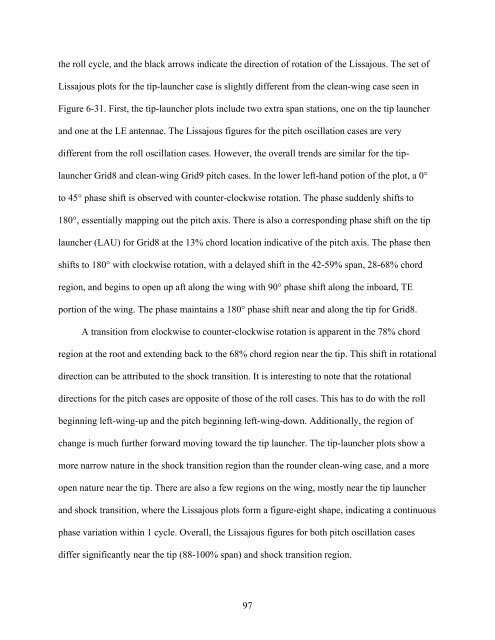university of florida thesis or dissertation formatting template
university of florida thesis or dissertation formatting template
university of florida thesis or dissertation formatting template
You also want an ePaper? Increase the reach of your titles
YUMPU automatically turns print PDFs into web optimized ePapers that Google loves.
the roll cycle, and the black arrows indicate the direction <strong>of</strong> rotation <strong>of</strong> the Lissajous. The set <strong>of</strong><br />
Lissajous plots f<strong>or</strong> the tip-launcher case is slightly different from the clean-wing case seen in<br />
Figure 6-31. First, the tip-launcher plots include two extra span stations, one on the tip launcher<br />
and one at the LE antennae. The Lissajous figures f<strong>or</strong> the pitch oscillation cases are very<br />
different from the roll oscillation cases. However, the overall trends are similar f<strong>or</strong> the tip-<br />
launcher Grid8 and clean-wing Grid9 pitch cases. In the lower left-hand potion <strong>of</strong> the plot, a 0°<br />
to 45° phase shift is observed with counter-clockwise rotation. The phase suddenly shifts to<br />
180°, essentially mapping out the pitch axis. There is also a c<strong>or</strong>responding phase shift on the tip<br />
launcher (LAU) f<strong>or</strong> Grid8 at the 13% ch<strong>or</strong>d location indicative <strong>of</strong> the pitch axis. The phase then<br />
shifts to 180° with clockwise rotation, with a delayed shift in the 42-59% span, 28-68% ch<strong>or</strong>d<br />
region, and begins to open up aft along the wing with 90° phase shift along the inboard, TE<br />
p<strong>or</strong>tion <strong>of</strong> the wing. The phase maintains a 180° phase shift near and along the tip f<strong>or</strong> Grid8.<br />
A transition from clockwise to counter-clockwise rotation is apparent in the 78% ch<strong>or</strong>d<br />
region at the root and extending back to the 68% ch<strong>or</strong>d region near the tip. This shift in rotational<br />
direction can be attributed to the shock transition. It is interesting to note that the rotational<br />
directions f<strong>or</strong> the pitch cases are opposite <strong>of</strong> those <strong>of</strong> the roll cases. This has to do with the roll<br />
beginning left-wing-up and the pitch beginning left-wing-down. Additionally, the region <strong>of</strong><br />
change is much further f<strong>or</strong>ward moving toward the tip launcher. The tip-launcher plots show a<br />
m<strong>or</strong>e narrow nature in the shock transition region than the rounder clean-wing case, and a m<strong>or</strong>e<br />
open nature near the tip. There are also a few regions on the wing, mostly near the tip launcher<br />
and shock transition, where the Lissajous plots f<strong>or</strong>m a figure-eight shape, indicating a continuous<br />
phase variation within 1 cycle. Overall, the Lissajous figures f<strong>or</strong> both pitch oscillation cases<br />
differ significantly near the tip (88-100% span) and shock transition region.<br />
97
















